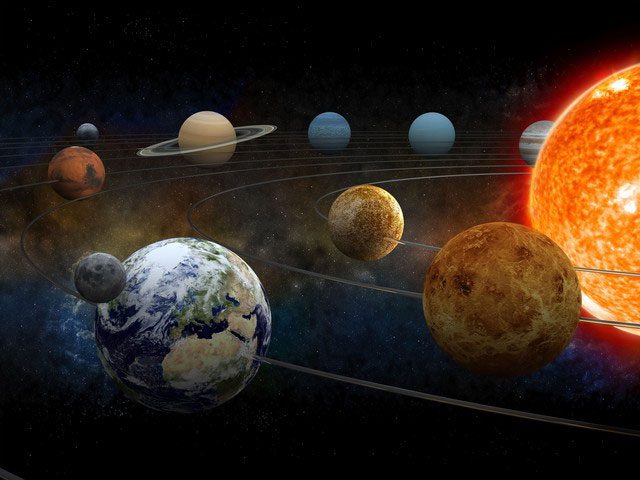Mysterious changes on Earth have always been the focus of scientists, and one of the issues attracting significant attention is the gradually increasing distance between Earth and the Sun.
Why Earth is Moving Away from the Sun: The Role of Planetary Dynamics
Earth’s oceans and atmosphere are influenced by the gravitational force of the Sun and the Moon, which causes tides. This immense gravitational force not only affects the rotation speed of Earth but also alters its orbit. Due to tidal forces, Earth is gradually pushed outward as it orbits the Sun, leading to an increasing distance from the Sun.
Gravitational perturbations are created by the interference of other celestial bodies on Earth. The Earth system includes not only the Sun and Earth but also other planets, moons, asteroids, etc. The mutual gravitational interactions among them create small changes in Earth’s orbital motion, which is known as perturbation. Although these changes are minimal, they accumulate over time, causing the distance between Earth and the Sun to change. Scientists have discovered through numerical simulations and observational data that the impact of this perturbation on the distance between Earth and the Sun cannot be overlooked.

Due to tidal forces, Earth is gradually pushed outward as it orbits the Sun.
However, even though the distance between Earth and the Sun is increasing over the long term, there is no need for excessive concern. According to scientists, this change occurs very slowly and will take hundreds of millions of years before significantly affecting Earth’s ecological and climatic conditions. Furthermore, in the coming billions of years, the Sun will enter the red giant phase, expanding in size and engulfing Earth, which is the real challenge that Earth will ultimately face.
Reasons for Earth’s Increasing Distance from the Sun: The Impact of Solar Wind on Earth
Solar wind is a stream of charged particles, including high-temperature plasma from the Sun’s outer atmosphere, escaping from the Sun’s surface at extremely high speeds. These charged particle streams travel throughout the Solar System and interact with planets and other celestial bodies.
The impact of solar wind on Earth primarily manifests in the formation of a region called the “ionosphere.” The ionosphere is a part of Earth’s atmosphere that contains a large amount of ions, located in the outer layer of the atmosphere. When charged particles in the solar wind approach Earth, they interact with Earth’s magnetic field, causing changes in the ions within the ionosphere.

Solar wind travels throughout the Solar System and interacts with planets.
This change directly impacts the planet. First, the activity of the solar wind adds a significant amount of energy to the ionosphere, causing it to expand outward, which in turn causes Earth’s atmosphere to expand. This means that Earth’s atmosphere can more easily trap lighter gases and particles from other celestial bodies, leading to a gradual increase in the atmosphere’s thickness.
Solar wind also disrupts Earth’s orbit. When it interacts with Earth’s magnetic field, it generates a force known as “solar wind pressure.” This pressure creates an uneven gas envelope around Earth, pushing or pulling Earth’s orbit. Although this pushing or pulling force is very small, over an extended period, it can gradually increase the distance between Earth and the Sun.

Solar wind has a very slow and minor impact on the distance between Earth and the Sun.
However, it is important to note that solar wind has a very slow and minor impact on the distance between Earth and the Sun. According to scientists’ estimates, the distance between Earth and the Sun increases by about 1.5 cm every 100 million years. This rate is negligible and does not directly affect life or the environment on Earth.
Effects of Earth’s Movement Away from the Sun: Gradual Temperature Changes
According to scientific studies, the average distance between Earth and the Sun is approximately 149.6 million kilometers. However, due to Earth’s elliptical orbit, the distance between Earth and the Sun is not fixed and gradually increases. Long-term observations show that the distance from Earth to the Sun increases by about 15 cm each year, which may seem insignificant but has significant impacts over long time scales.
As the distance from Earth to the Sun increases, the amount of radiant heat from the Sun reaching Earth’s surface gradually decreases. Solar radiation is the primary heat source on Earth, making surface temperatures suitable for the survival of humans and other organisms. However, as Earth moves away from the Sun, solar radiation cannot fully cover Earth’s surface, causing temperatures to decrease.

Solar radiation is the primary heat source on Earth.
This temperature decrease brings a series of challenges for human society and the natural environment.
- Firstly, agricultural production and food supply will be severely affected. Lower temperatures can impact the growth and yield of crops, leading to food shortages and rising food prices.
- Secondly, colder climate conditions may lead to higher energy demands as people need to heat homes and office spaces, which will increase energy consumption and emissions.
- Additionally, ecosystems will also be threatened, with many animal and plant species potentially unable to adapt to the colder environment, leading to extinctions and a decline in biodiversity.
However, the increasing distance of Earth from the Sun also presents opportunities. First, it means we have more time to address the challenges of climate change. Compared to planets closer to the Sun, Earth is situated in a more habitable zone.
We can leverage this time to mitigate the impacts of climate change by reducing greenhouse gas emissions, developing renewable energy sources, and implementing environmental protection measures. Secondly, the increasing distance of Earth from the Sun also opens up new opportunities for exploring the Solar System. In the future, we may utilize this relatively stable distance to conduct deeper research into the properties and potential of other planets within the Solar System.

The Earth’s magnetic field is crucial for the orientation of living organisms.
The increasing distance of Earth from the Sun may also change Earth’s magnetic field. The Earth’s magnetic field is vital for the orientation of living organisms. Some animal species rely on Earth’s magnetic field for migration and navigation, and as the magnetic field changes, their migratory paths and navigational abilities may be disrupted. This could confuse some organisms that depend on Earth’s magnetic field, hindering their ability to migrate and navigate normally, which negatively affects their survival and reproduction.
Regardless, we cannot overlook the importance of the mysterious changes on Earth and their impacts on humanity. Regarding temperature changes, we need to conduct more in-depth studies and observations to better understand the dynamics of Earth’s environment. Only through scientific exploration and explanation can we better cope with the challenges of climate change and protect our beautiful home planet.


















































